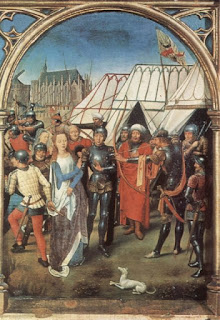The legend of Saint Ursula and her 11,000 virgin followers
Before the German Roman Calendar was revised in 1969, the 21st of October was dedicated to the Romano-British Christian, Saint Ursula. There have never been certain answers about her life and who exactly she was.
According to historians, Ursula lived in the period between 300 and 600 AD but is not known precisely when. There are various stories about her life, but the legend states that Ursula and her 11,000 followers, a group of holy virgins, were killed by the Huns in Cologne on an uncertain date.
Saint Ursula – Virgin and Martyr
Saint Ursula in a fifteenth century fresco on the St. Jacob church in Urtijëi in Val Gardena. Photo credit
Saint Ursula statue, St. Ursula Church, Cologne, Germany. Photo credit
According to the legend, Ursula was a princess, the daughter of King Dionotus of Dumnonia, the region known today as Dorset, Devon, and Somerset. One day, joined by 11,000 handmaidens, all virgins, Ursula sailed off to the coast of Brittany, to meet her future husband – the pagan governor Conan Meriadoc of Armorica.
There was a storm, which in any other case would have wrecked their ship, and all of the women would have been killed, but instead, the storm brought them to a Gaulish port in a single day.
Map of Briton settlements in the sixth-century
Saint Ursula, by Stefan Lochner
Travel companions of Saint Ursula
Following this event, Ursula announced that she would go on a pan-European pilgrimage before her marriage, and left for Rome with all of her 11,000 followers. There, she convinced the Pope, Cyriacus (probably Pope Siricius) and Sulpicius, Bishop of Ravenna, to join her. Unfortunately, when Ursula and her virgin followers arrived in Cologne, Germany, they were massacred by the Huns because they refused to copulate or marry them. It is said that Ursula, as the leader of the group, was shot with an arrow by the Huns’ leader. The date varies, but this is generally said to have happened around 383 AD.
Altarpiece of the anonymous painter
The Legend of Saint Ursula
The Martyrdom of Saint Ursula, by Hans Memling
The Martyrdom of Saint Ursula (German art, sixteenth century)
Saint Ursula and her followers
Martyrdom of Saint Ursula, by Caravaggio
Saint Ursula by Hans Holbein
Some historians argued that Ursula was on her holy pilgrimage before her marriage, that Rome was her final destination, and that a shipwreck caused by a storm led the survivors into the hands of the Huns. They were imprisoned and beheaded, while Ursula was shot by an arrow. And in a different version of the legend, it is believed that King Dionotus sent the women to become wives for the settlers of the newly founded region of Armorica, and Ursula to become the wife of Armorica’s ruler – Conan Meriadoc. In this version, the ship with the women never arrived.
There are very few records about Ursula or the possible 11,000 virgins who were been murdered in Cologne, especially after the ninth century. Only legends that refer to a small number of martyrs, and in which the name of Ursula got forgotten through time, remain. However, it is certain that the Roman Senator Clematius built the church of St. Ursula in Cologne, in memory of the murdered women. The church has been built upon the remains of an ancient Roman cemetery where it is believed Ursula and her 11,000 followers have been buried.
The church from the east. Photo credit
Interior of the church of St. Ursula. Photo credit
One of the walls of bones in the Golden Chamber. Photo credit
A portion of the collection of skull relics in the Golden Chamber. Photo credit
Ursulaschrein (Hans Memling, before 1489)
Bust of the saint in the heart of St. Ursula in Cologne. Photo credit
There is also a legend that states that the number of virgins who accompanied Ursula was 11.
Read another story from us: The famous painting “The Virgin and Child with Saint Anne” offers a glimpse into the subconscious of Leonardo da Vinci
But whether it is 11 or 11,000, the walls of the Golden Chamber, or Goldene Kammer, of the church are covered in bones arranged in designs and letters along with relic skulls. In 1920, the church was granted the status of Basilica by the Pope.













No comments:
Post a Comment